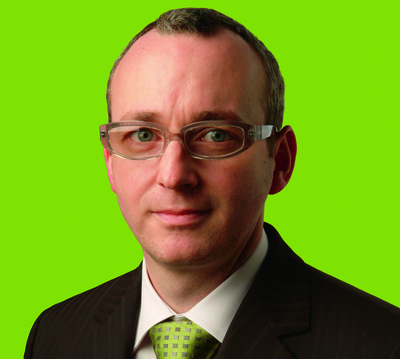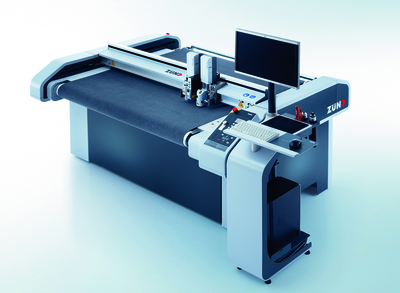The Esko kongsberg
Speed and reliability are the pre-requisites for digital cutting tables in today’s wide format market, and are the areas that developers are continually looking to improve.
Time was in the wide format sector that a single cutting machine could keep pace with the output from multiple printing machines. Not so any longer, as digital printing takes over and leaps forward continuously in productivity terms. Nowadays, reflects Blackman & White managing director Alex White, you need one cutter per printer because print speeds have become so rapid.
That fact alone means that more of you out there will be having to weight up a digital cutting table purchase sometime in the intermediate future. Add to that the fact that increasing numbers of commercial printers are moving into wide format production, and the necessity becomes even more pressing.
The options are not just Zünd and Esko Kongsberg either. Although these are indisputably the biggest names, there are other suppliers who just might be worth speaking to, especially for the more budget-conscious printer. This does not mean that you should aim cheap though. You might pick up a Chinese manufactured machine for a fraction of the price of an Esko or a Zünd, but in the long run it might not be the best decision.
‘You can buy a Lasercomb ProDigi Neo for about £75,000, reasonably specified with the routing system, oscillating cutter etc. but a Chinese machine might only cost around £18,000,’ said John Harrison of Friedheim International, which sells the aforementioned Lasercomb cutters. ‘It’s the service and support that customers are really nervous about. After probably two or three years you have to replace it, whereas our machines, the Zünds and Eskos will last for 20 years.’
Twenty years is not necessarily an exaggeration, and you do need to think about the long run. Just consider the words of Esko’s Paul Bates: ‘When you want reliability and up-time, then the Kongsberg is perfect. Some customers have 20 year old Kongsbergs, but in sign & display some are working 24/7 so they probably won’t last for that long. Even so, we envisage a Kongsberg will see two to three printer investments out, before the customer has to replace the Kongsberg table.’

Esko’s Paul Bates
Having to think about the long run means that ‘future proofing’ a wide format cutting system is advisable. It might be good for today, but will it still be performing as you need in five years’ time? Mr Bates continued: ‘Make sure that you get a machine and a configuration that is future proofed; don’t just think about what you are doing now but also what you’ll be doing in 10 years, because a Kongsberg table will keep going. You need the flexibility to upgrade for the future: new tooling, new cutting systems, new registration systems.’
AG/CAD’s general manager Paul Andrade points out that many customers buying a digital cutting table for the first time, do so via the company’s KM7 table. They then find that new markets open up for them and graduate to the much more productive and highly specified DYSS table, which he claims is ‘in the same league of productivity as a Zünd’ but with list prices 25-30% lower on a like-for-like basis. The DYSS is made in Korea.
Issues of cost, reliability, service and support, and longevity are bound to be uppermost in a company’s mind, but they also need a good grasp in the first instance of what kind of materials they will be cutting on the table. Most cutting tables today can be configured with tooling options so, for example, they can be equipped with cutting knives as well as routers, the latter to deal with comparatively (in the graphics world) hard materials such as Perspex and Dibond. But there are those that are more suitable for one or the other because of the concept behind their build and the robustness of the components used in manufacture.
Liam Hodson, technical sales engineer at Wolverhampton-based AXYZ International (pronounced AXIZ) told Digital Printer: ‘Where AXYZ comes in is from the heavier routing side. There are quite a few machines – the Esko and Zünd tables for example – that are designed more for print finishing with a knife, but have routing capability added, while ours are the opposite: they are routers with a knife put on them. If a company is just doing vinyl, there are probably more efficient machines elsewhere, although they might cost more. They are very different machines.’
Blackman & White’s Versa-Tech flatbed cut and route system, manufactured in Essex, is another cutting system that can perform both types of work, and it also has a third string to its bow, reported Alex White: ‘We have engineered it to carry a laser, so on the same machine that you can do routing and oscillating knife cutting, you can also laser cut acrylic and fabric, which is one area that we are seeing a large amount of growth – dye sublimation where you need to cut a 3.2 metre textile. The best way to do that is with a laser. Having that edge gives a more desirable finish, and in some cases removes the necessity to hem and stitch.’
The company’s Genesis cutting tables meanwhile can only perform knife and laser cutting, but there are two interesting aspects of the market that are introduced here by Mr White’s comments: laser cutting and growth in textiles.

The Zund S3 with conveyor
New laser cutting technologies have been hitting the market in recent times, but not everyone is a fan. ‘With paper and board substrates you can leave marks on the sheets,’ observed Friedheim’s John Harrison. ‘Lots of companies moved away from lasers because they are not comfortable with something that’s capable of causing a fire in the factory. They also cannot produce a good quality crease; you’re doing a half-cut and it is very unattractive.’
He added that he could understand the interest in laser cutting because of the speed factor, and that it may suit some markets, but he feels that the quality of the cut needs to improve, and there is also a lot more maintenance and support required than would be necessary with a standard digital cutting table.
Esko’s Paul Bates commented: ‘We could always be faster, and we plan to be. We are working on optimising speeds and different ways of cutting a substrate. Everyone thinks of lasers but they are not very good because they damage the substrate. It’s going to be an interesting next two years for us all.’
Asked what he meant by this, he was only prepared to say that something is coming that is going to be a big development for the market. He added: ‘Every print company out there is getting quicker and quicker, and we have to be looking for ways to finish more quickly.’
So, let us say you are in the market for a new wide format cutting table. What questions should you be asking yourself? ‘The hidden thing is after-sales support,’ said AG/CAD’s Paul Andrade; ‘what’s in the warranties? Often companies restrict that on the more expensive parts of the machine. What’s the ongoing maintenance of the machine? Spare parts? What’s the back up?’
Liam Hodson from AXYZ agrees: ‘It’s the back-up, service and support that goes with the machine. It could be the best machine in the world, but if you’ve got no service and spare parts it becomes a glorified work bench. It’s not the capabilities of the machine, it’s the after-sales and back-up which is critical.’





